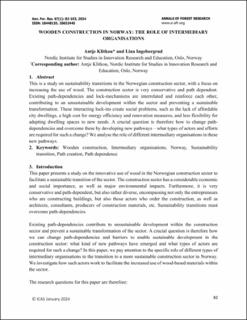| dc.contributor.author | Ingeborgrud, Lina | |
| dc.contributor.author | Klitkou, Antje | |
| dc.date.accessioned | 2024-02-13T12:39:18Z | |
| dc.date.available | 2024-02-13T12:39:18Z | |
| dc.date.created | 2024-02-12T17:12:22Z | |
| dc.date.issued | 2024 | |
| dc.identifier.citation | Annals of Forest Research. 2024, 67 (1), 82-103. | en_US |
| dc.identifier.issn | 1844-8135 | |
| dc.identifier.uri | https://hdl.handle.net/11250/3117294 | |
| dc.description.abstract | This is a study on sustainability transitions in the Norwegian construction sector, with a focus on increasing the use of wood. The construction sector is very conservative and path dependent. Existing path-dependencies and lock-mechanisms are interrelated and reinforce each other, contributing to an unsustainable development within the sector and preventing a sustainable transformation. These interacting lock-ins create social problems, such as the lack of affordable city dwellings, a high cost for energy efficiency and renovation measures, and less flexibility for adapting dwelling spaces to new needs. A crucial question is therefore how to change pathdependencies and overcome these by developing new pathways – what types of actors and efforts are required for such a change? We analyse the role of different intermediary organisations in these new pathways. | |
| dc.language.iso | eng | en_US |
| dc.relation.uri | www.inno4tree.no | |
| dc.title | Wooden construction in Norway: the role of intermediary organisations | en_US |
| dc.title.alternative | Wooden construction in Norway: the role of intermediary organisations | en_US |
| dc.type | Peer reviewed | en_US |
| dc.type | Journal article | en_US |
| dc.description.version | publishedVersion | |
| dc.source.pagenumber | 82-103 | en_US |
| dc.source.volume | 67 | en_US |
| dc.source.journal | Annals of Forest Research | en_US |
| dc.source.issue | 1 | en_US |
| dc.identifier.cristin | 2245260 | |
| dc.relation.project | Norges forskningsråd: 2526530 | |
| cristin.ispublished | true | |
| cristin.fulltext | original | |
| cristin.qualitycode | 1 | |
